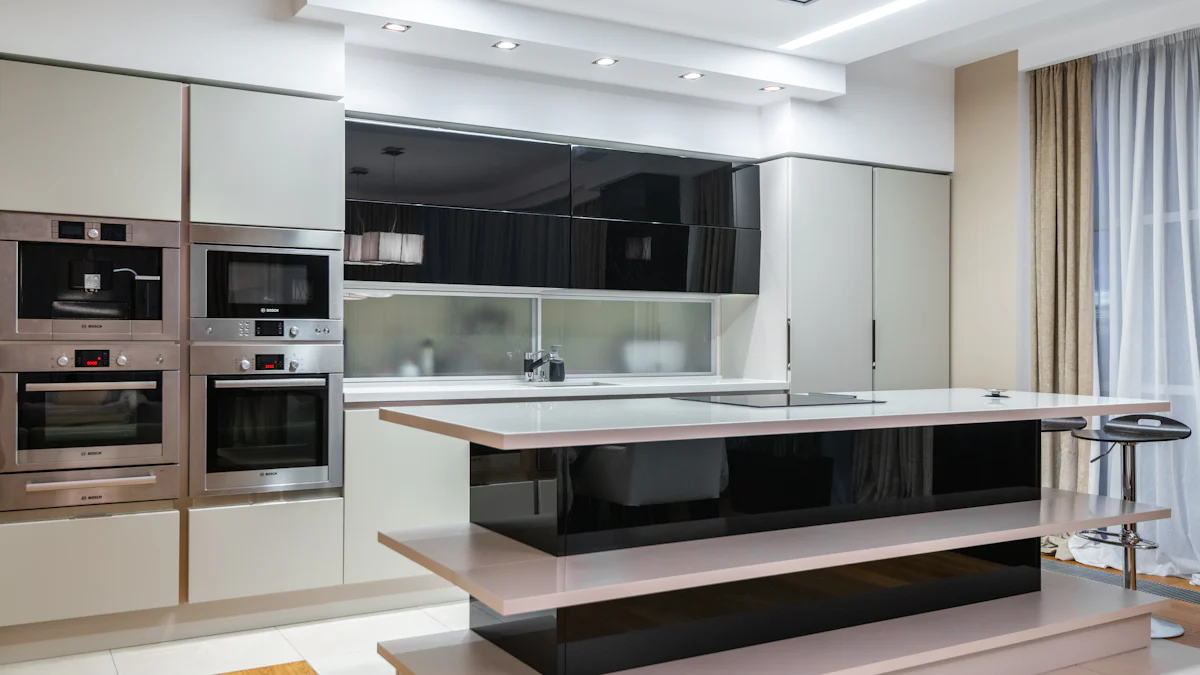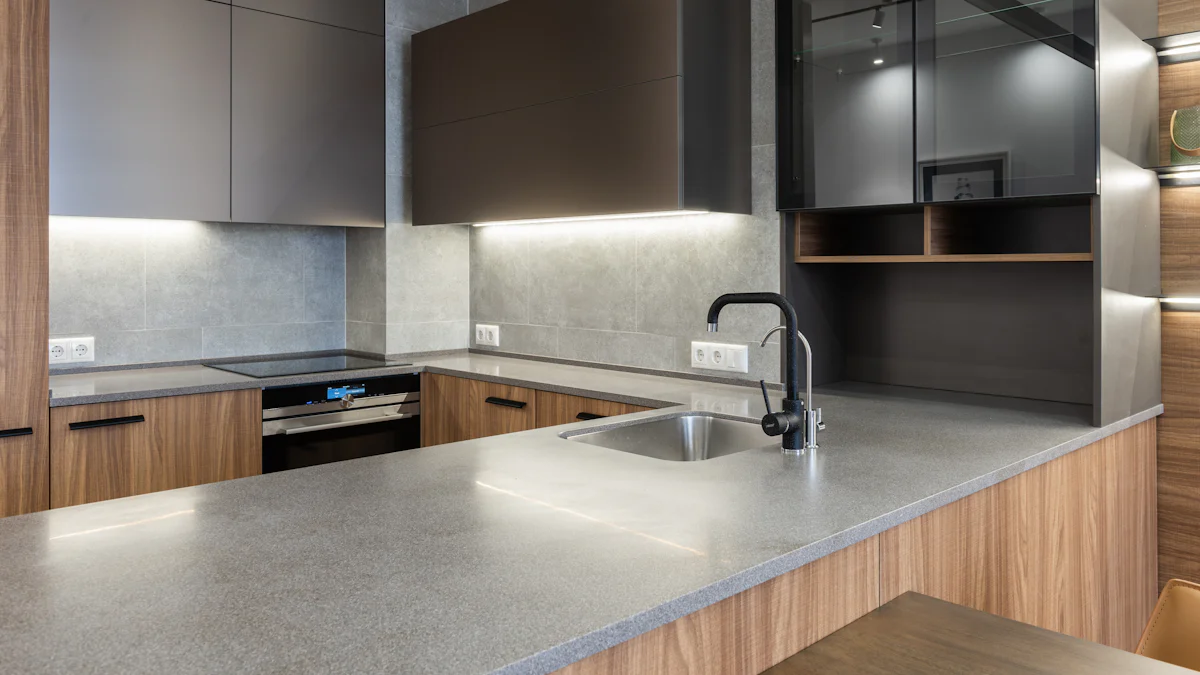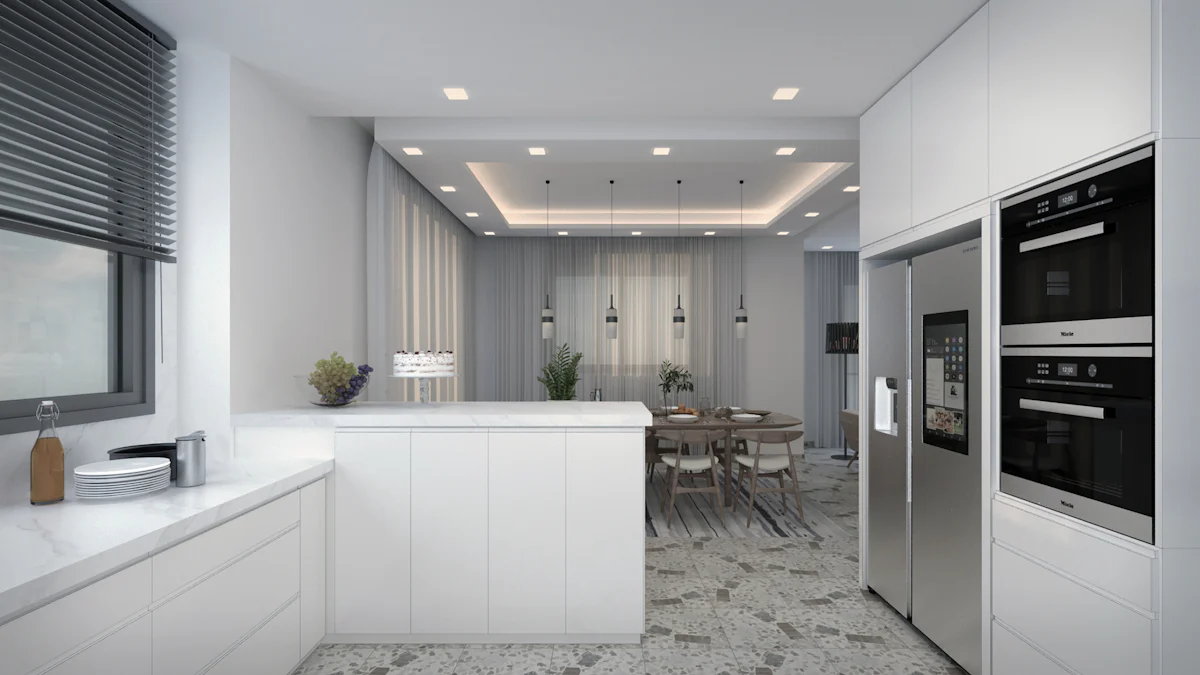User Reviews of Downdraft Induction Cooktops in 2024

Are you considering upgrading your kitchen with a modern cooking solution? A downdraft induction cooktop might be the game-changer you need. These innovative appliances combine sleek design with cutting-edge technology, offering precise cooking control and built-in ventilation. With induction technology growing by 62% since 2018, more people are exploring this option for their homes. But is it the right fit for your kitchen? By diving into user experiences and preferences, you’ll discover whether this stylish and efficient cooktop aligns with your cooking needs.
Key Takeaways
Downdraft induction cooktops save space by integrating ventilation directly into the cooking surface, making them ideal for modern and compact kitchens.
These cooktops provide efficient ventilation, effectively removing smoke and odors at the source, ensuring a fresh cooking environment.
Induction technology offers precise cooking control, allowing for faster heating and energy savings, which can lower utility bills over time.
User-friendly touch controls simplify operation, making it easy for both novice and experienced cooks to adjust settings effortlessly.
While downdraft systems are effective for light to moderate cooking, they may struggle with heavy-duty tasks, so consider your cooking habits before purchasing.
Installation can be complex and may require modifications to your kitchen layout, so plan accordingly to avoid unexpected costs.
Investing in a downdraft induction cooktop can enhance your kitchen's aesthetic and functionality, providing long-term value despite a higher initial cost.
Benefits of Downdraft Induction Cooktops

Space-Saving Design
A downdraft induction cooktop is perfect for maximizing your kitchen space. Unlike traditional setups that require bulky overhead range hoods, these cooktops integrate ventilation directly into the cooking surface. This design eliminates the need for additional equipment above your stove, freeing up valuable overhead space. Whether you have a compact kitchen or an open-concept layout, this feature creates a cleaner, more streamlined look. You’ll also enjoy the flexibility to place your cooktop on an island or against a wall without worrying about obstructing your view or disrupting the flow of your kitchen.
Improved Ventilation Efficiency
Say goodbye to lingering smoke and odors in your kitchen. Downdraft induction cooktops come equipped with built-in ventilation systems that pull fumes, steam, and grease directly from the cooking surface. This innovative approach ensures that air is cleared right at the source, keeping your kitchen fresh and comfortable. Many models offer powerful motors that can vent air outside or recirculate it through filters, depending on your setup. This versatility makes them a great choice for kitchens with tall ceilings or spaces where traditional range hoods aren’t practical. Plus, the quiet operation of these systems means you can cook without the constant hum of a noisy fan.
Sleek and Modern Aesthetic
If you’re aiming for a contemporary kitchen design, a downdraft induction cooktop delivers both style and functionality. These appliances boast clean lines, minimalist surfaces, and intuitive touch controls that blend seamlessly into modern kitchens. Without the visual clutter of an overhead hood, your kitchen feels more open and inviting. Some models even feature award-winning designs, making them a centerpiece in your home. Whether your kitchen leans toward classic elegance or cutting-edge modernity, these cooktops add a touch of sophistication that elevates the entire space.
Energy Efficiency and Precision Cooking
When it comes to energy efficiency, a downdraft induction cooktop stands out as a top choice for modern kitchens. Induction technology uses electromagnetic fields to directly heat your cookware, ensuring minimal energy loss. Unlike gas or electric cooktops, which heat the surrounding air, induction cooktops transfer energy with remarkable precision. This means you can boil water faster, reduce cooking times, and save on energy bills.
Precision cooking is another standout feature. With multiple power levels and booster options, you can fine-tune the heat to match your recipe’s exact requirements. Whether you're simmering a delicate sauce or searing a steak, the consistent temperature control ensures perfect results every time. Many models also include bridge zones, allowing you to combine two cooking areas into one larger zone. This feature is ideal for oversized pots or griddles, giving you more flexibility in your cooking.
The intuitive touch-through-glass controls make adjustments effortless. You can quickly change power levels or activate the booster function with just a tap. This user-friendly interface not only enhances your cooking experience but also adds to the sleek, modern aesthetic of your kitchen. Plus, the energy-efficient design aligns with sustainable living, making it a smart choice for eco-conscious homeowners.
User Experiences with Downdraft Induction Cooktops
Positive Feedback
Ease of Use and Intuitive Controls
Many users rave about how simple downdraft induction cooktops are to operate. The touch-through-glass controls make adjusting heat levels quick and effortless. You can switch between power settings or activate features like the booster function with just a tap. This intuitive design eliminates the guesswork, making cooking more enjoyable. Whether you're a seasoned chef or a beginner, you'll appreciate how these controls streamline your cooking process.
Quiet and Effective Ventilation
One standout feature users frequently highlight is the quiet operation of the built-in ventilation system. Unlike traditional overhead range hoods that can be noisy, downdraft systems work discreetly in the background. This makes them especially appealing for open-concept kitchens or island installations where noise can disrupt conversations. While the ventilation may not match the power of larger overhead systems, many users find it effective for everyday cooking tasks. It keeps your kitchen fresh without the constant hum of a loud fan.
Enhanced Cooking Performance
Cooking enthusiasts often praise the performance of downdraft induction cooktops. Induction technology heats cookware directly, allowing you to boil water up to 40% faster than gas or electric stoves. This efficiency not only saves time but also reduces energy consumption. Precise temperature control ensures consistent results, whether you're simmering a delicate sauce or searing meat. Many models include features like bridge zones, which let you combine cooking areas for larger pots or griddles. These capabilities make cooking more versatile and enjoyable.
Common Complaints
Challenges with Installation
Some users report difficulties during installation. Downdraft induction cooktops require specific ventilation setups, which can complicate the process. If your kitchen layout isn't already designed for this type of appliance, you might need to make significant adjustments. This could involve modifying cabinetry or ensuring proper electrical connections. While these challenges aren't insurmountable, they can add to the overall cost and effort of upgrading your kitchen.
Limited Ventilation Power for Heavy Cooking
While the built-in ventilation works well for light to moderate cooking, some users find it less effective for heavy-duty tasks. High-heat cooking or frying can produce more smoke and grease than the downdraft system can handle. This limitation may leave you needing additional ventilation support, especially if you frequently cook dishes that generate a lot of fumes. It's something to consider if you often prepare meals that require intense heat.
Higher Initial Cost Compared to Traditional Options
The advanced technology and sleek design of downdraft induction cooktops come at a price. Many users note that these appliances cost more upfront than traditional gas or electric stoves. While the long-term energy savings and enhanced cooking experience may offset this expense, the initial investment can be a hurdle. If you're on a tight budget, this higher cost might make you think twice before making the switch.
Comparing Downdraft Induction Cooktops to Traditional Options

Ventilation: Downdraft vs. Overhead Range Hoods
When it comes to ventilation, downdraft systems offer a unique approach. Instead of pulling smoke and odors upward like overhead range hoods, they draw them downward directly from the cooking surface. This design works well for light to moderate cooking. It keeps your kitchen fresh without the need for bulky equipment hanging above your stove. Many users appreciate how quiet these systems are, especially in open-concept kitchens where noise can disrupt conversations.
However, overhead range hoods often outperform downdraft systems in heavy-duty cooking scenarios. If you frequently fry or cook at high heat, you might notice downdraft systems struggling to handle the extra smoke and grease. Overhead hoods, with their larger motors and higher airflow capacity, excel in these situations. Choosing between the two depends on your cooking habits and how much ventilation power you need.
Cooking Performance: Induction vs. Gas and Electric Cooktops
Induction cooktops, including downdraft models, deliver unmatched precision and efficiency. They use electromagnetic fields to heat your cookware directly, which means faster cooking times and less energy waste. You can boil water in minutes or maintain a steady simmer without constant adjustments. This level of control makes induction ideal for recipes that require exact temperatures.
Gas cooktops, on the other hand, provide a visual flame that many chefs love. They offer instant heat and work well with all types of cookware. However, they lose heat to the surrounding air, making them less efficient than induction. Electric cooktops fall somewhere in between. They’re easy to clean and affordable but lack the speed and precision of induction.
If you value speed, energy savings, and precise temperature control, induction is the clear winner. But if you prefer the traditional feel of cooking with gas or need a budget-friendly option, gas or electric might suit you better.
Design and Space Considerations
Downdraft induction cooktops shine in modern kitchen designs. Their sleek, minimalist look eliminates the need for an overhead hood, creating a clean and open aesthetic. This makes them perfect for island installations or kitchens with limited space. You can enjoy unobstructed views and a clutter-free environment, which enhances the overall flow of your kitchen.
Traditional setups with overhead range hoods require more space and can dominate the visual design of your kitchen. While they’re effective, they may not blend as seamlessly into contemporary layouts. If you’re aiming for a streamlined and stylish kitchen, a downdraft induction cooktop offers both form and function.
Ultimately, your choice depends on your priorities. Do you want a modern, space-saving solution? Or do you need the raw power and versatility of traditional options? By weighing these factors, you can find the perfect fit for your kitchen.
Tips for Choosing the Right Downdraft Induction Cooktop
Choosing the perfect downdraft induction cooktop for your kitchen can feel overwhelming, but focusing on a few key factors will simplify the process. Here’s what you should keep in mind to make an informed decision.
Key Features to Look For
Ventilation Power and Settings
The built-in ventilation system is one of the most important aspects of a downdraft induction cooktop. You’ll want to ensure it has enough power to handle your cooking habits. If you frequently cook at high heat or fry foods, look for models with adjustable ventilation settings. These allow you to increase the power when needed, ensuring smoke and odors are effectively removed. Some models also offer recirculation options, which can be helpful if external venting isn’t possible in your kitchen.
Cooking Zones and Power Levels
Pay attention to the number and size of cooking zones. A good downdraft induction cooktop should offer multiple zones with varying power levels to accommodate different cookware sizes. Features like bridge zones can be a game-changer if you use oversized pots or griddles. Additionally, check for booster functions that let you quickly heat up a zone for tasks like boiling water. These features enhance flexibility and make cooking more efficient.
Safety Features
Safety should always be a priority when selecting any kitchen appliance. Look for cooktops with features like automatic shut-off, child locks, and residual heat indicators. These features not only protect you and your family but also add peace of mind while cooking. Induction technology itself is safer than gas or electric options since the surface remains cool to the touch, reducing the risk of burns.
Installation Considerations
Space and Layout Requirements
Before purchasing, evaluate your kitchen’s layout. Downdraft induction cooktops require specific space configurations to accommodate the built-in ventilation system. Measure your countertop area carefully and ensure there’s enough room for proper installation. If you’re planning to place the cooktop on an island, double-check that the ventilation system won’t interfere with the cabinetry below.
Electrical and Ventilation Setup
Downdraft induction cooktops often need a dedicated electrical circuit due to their power requirements. Make sure your kitchen’s electrical system can support the appliance. Additionally, consider the ventilation setup. Some models vent air outside, while others recirculate it through filters. If you choose an external venting model, you may need to install ductwork, which could increase installation costs.
Budget and Long-Term Value
While downdraft induction cooktops tend to have a higher upfront cost compared to traditional options, they offer long-term value. Their energy efficiency can lower your utility bills over time, and their sleek design adds a modern touch to your kitchen. When setting your budget, factor in not just the purchase price but also installation costs and potential savings on energy. Investing in a high-quality model with durable materials and advanced features will pay off in the long run.
By focusing on these factors, you’ll find a downdraft induction cooktop that fits your needs and enhances your cooking experience. Whether you prioritize ventilation power, cooking performance, or design, there’s a model out there that’s perfect for your kitchen.
Downdraft induction cooktops offer a unique blend of style, efficiency, and functionality. They save space, enhance your kitchen’s aesthetic, and provide precise cooking performance. However, challenges like installation complexity and limited ventilation power for heavy cooking should not be overlooked. To make the best choice, consider your cooking habits, kitchen layout, and budget. Think about how often you cook, the type of meals you prepare, and the space available in your kitchen. By weighing these factors, you can confidently decide if a downdraft induction cooktop is the right fit for your home.
FAQ
What makes downdraft induction cooktops more expensive than traditional options?
Downdraft induction cooktops cost more because they combine two advanced technologies: induction cooking and integrated ventilation. The built-in ventilation system eliminates the need for a separate overhead hood, which adds to the overall price. While the upfront cost is higher, many users find the sleek design and space-saving benefits worth the investment.
How effective is the ventilation system in downdraft cooktops?
The ventilation system in downdraft cooktops works well for light to moderate cooking. It pulls smoke, steam, and odors directly from the cooking surface, keeping your kitchen fresh. However, it may struggle with heavy smoke or grease from high-heat cooking or frying. If you frequently cook meals that produce a lot of fumes, you might need additional ventilation support.
Can downdraft induction cooktops replace overhead range hoods?
Yes, downdraft induction cooktops can replace overhead range hoods in many kitchens. They eliminate the need for bulky overhead ventilation by pulling air downward through the cooktop. This makes them a great option for kitchens where traditional hoods aren’t feasible, such as those with tall ceilings or island installations.
Are downdraft induction cooktops suitable for small kitchens?
Absolutely! Downdraft induction cooktops are perfect for small kitchens. Their space-saving design integrates the ventilation system into the cooktop, freeing up overhead space. This creates a cleaner, more open look, making them ideal for compact or minimalist kitchen layouts.
Do downdraft induction cooktops work with all types of cookware?
Induction cooktops require cookware made of magnetic materials, such as stainless steel or cast iron. If your pots and pans aren’t induction-compatible, you’ll need to invest in new ones. To check, place a magnet on the bottom of your cookware. If it sticks, it’s compatible.
How difficult is it to install a downdraft induction cooktop?
Installing a downdraft induction cooktop can be more complex than traditional options. You’ll need to ensure proper ventilation and electrical connections. Some models require external ductwork, while others use recirculating filters. If your kitchen isn’t already set up for this type of appliance, you may need to modify your cabinetry or layout.
Are downdraft induction cooktops energy-efficient?
Yes, downdraft induction cooktops are highly energy-efficient. Induction technology heats cookware directly, reducing energy loss. This efficiency not only lowers your utility bills but also speeds up cooking times. It’s an eco-friendly choice for homeowners looking to save energy.
Do downdraft induction cooktops make a lot of noise?
No, most downdraft induction cooktops operate quietly. The built-in ventilation system is designed to work discreetly, making it much quieter than traditional overhead range hoods. This feature is especially appreciated in open-concept kitchens where noise can disrupt conversations.
Can I use a downdraft induction cooktop on a kitchen island?
Yes, downdraft induction cooktops are a popular choice for kitchen islands. Their integrated ventilation system eliminates the need for an overhead hood, allowing for unobstructed views and a clean, modern aesthetic. Just ensure your island has enough space and proper ventilation setup for installation.
Are downdraft induction cooktops worth the investment?
If you value style, space-saving design, and precise cooking performance, downdraft induction cooktops are worth considering. While they have a higher upfront cost, their energy efficiency and modern features provide long-term value. Evaluate your cooking habits, kitchen layout, and budget to decide if they’re the right fit for you.
See Also
Innovative Features of Induction Cooktops with Downdrafts
Evaluating Brand Performance of Downdraft Electric Cooktops
Essential Information on Induction Cooktops Featuring Downdrafts

